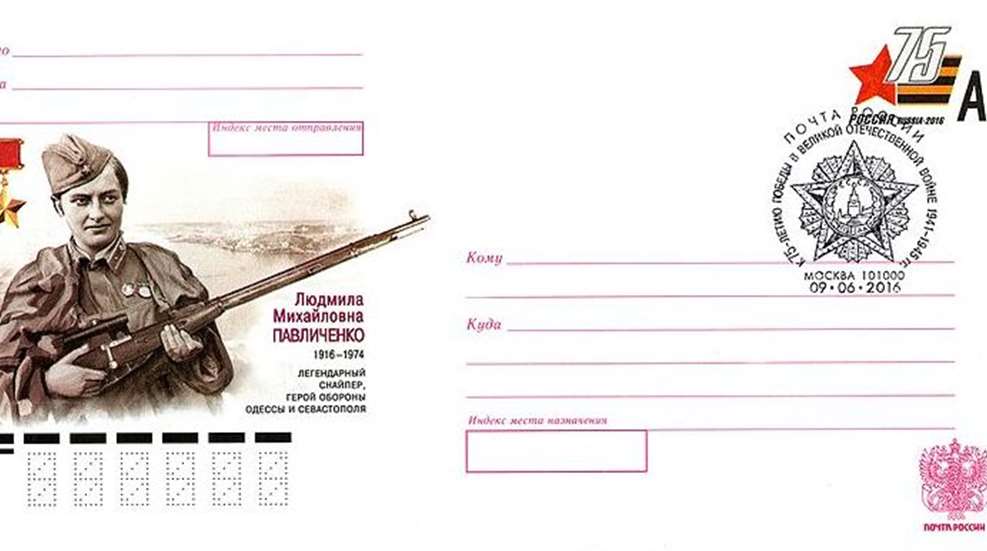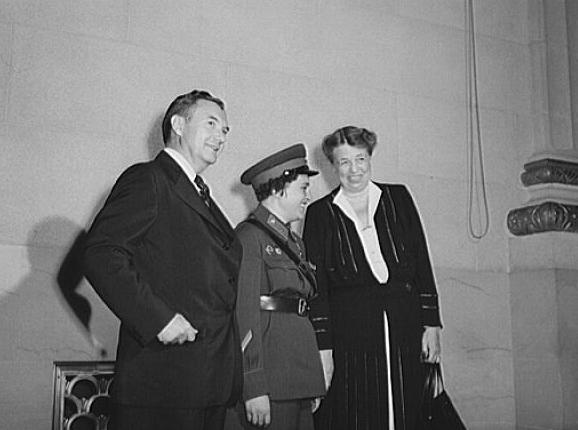
The memory of the Soviet Union is, nowadays, almost synonymous with tales of dubious science and outlandish propaganda. It is in such a vein that the fascinating story of Lyudmila Pavlichenko is often discounted, particularly by those who know the Soviet propaganda machine all too well. Intriguingly enough, as best we can tell 70-odd years removed, every word is true. So who exactly is this Lyudmila Pavlichenko, who lived a life thought strange enough to be fiction? If you asked her, she would probably tell you, "just an ordinary soldier of the Soviet Union."
Lyudmila was born in 1916 in Bila Tserkva, in what is now Ukraine. A headstrong tomboy, she moved with her family to Kiev at the age of 14, where she found employment as a metal grinder in the Arsenal munitions factory. Though some would call this an odd case of foreshadowing considering her future profession, the truth of the matter is that it would have been stranger had she not. The Soviet Union, still barely a decade removed from the October revolution, was in the throes of a massive spate of industrialization, centered heavily upon the military.
As she tells the story, it was around this time her interest in shooting was first piqued by Fyodor Kuschenko, the often boastful instructor of her factory’s shooting circle. Not contented to simply sit and listen, Lyudmila set out to show him what she could do, completely unaware she would someday show the world as well. One day after work, Fyodor took her to the range and introduced her to her first rifle: a small-bore, single-shot TOZ-8, from the still-extant Tula arms factory. It was small by the standards of the day, a mere 111 cm to be precise, and fired only a 5.6x16mm through its thick barrel. But the first four shots Lyudmila fired out of the ‘Melkasha,’ as it was colloquially known, all found paper at 25 meters. Thus “Lady Death” was born.
Training incessantly in her factory shooting circle, Lyudmila soon joined OSOAVIAKhIM (not to be confused with Operation Osoaviakhim, or the airship Osoaviakhim -1), a paramilitary youth program to familiarize citizens with weapons and proper etiquette. There she took part in numerous shooting competitions, even aspiring to achieve the “Voroshilov Marksman” badge, second degree, which entailed not just sharpshooting, but also navigation, grenade throwing and physical training.
After a four-year stint in the Arsenal munitions factory, and the birth of her son Rostislav, Lyudmila enrolled at Kiev University, where she took an interest in politics, ancient history and English. Her interest in politics kept Lyudmila quite well informed about foreign goings-on (by Soviet standards anyway), and thus in her second year, with the clouds of war gathering, she decided to refresh her marksmanship skills by enrolling in the two-year OSOAVIAKhIM sniper course in Kiev. It was here, instructed by the legendary Alexander Vladimirovich Potapov, that Lyudmila had her first experiences with the Mosin model 1891/1930, a variant of which she would carry throughout the war. The “Three Line”, as it was known among the rank and file, fired the now-renowned 7.62 x 54mm R cartridge, still used in combat today in Dragunovs, and a few other rifles.
Not long after Lyudmila graduated from OSOAVIAKhIM sniper school in 1939, the ominous sound of German tanks echoed over the Polish landscape for the first time in decades, kicking off WWII in a fittingly gruesome marriage of violence and machinery. Though it took a little over a year, those tanks eventually rolled all the way to the border of the USSR, changing Lyudmila’s life in a way that would forever scribe her name into the annals of history.
When she first attempted to enlist, in late June of 1941, Lyudmila was turned away from service with an admonishment to try nursing instead, an attitude which she was to encounter off and on throughout her career. Upon approaching a different registrar the next day however, her credentials were recognized, and she was promptly enrolled in the 25th Chapayev Rifle Division.
After reaching the division, Lyudmila was sharply awakened to just what dire straits the USSR was in. The Soviet Union was so low on weapons at the time that she was not even issued a rifle, much less a sniper rifle. Instead, as a new recruit, her only tools were to be a spade and a single hand grenade.
As it happened, a standard Mosin rifle didn’t fall into her hands for about a month, and even then it only came to her when a neighboring soldier was severely injured. Lyudmila quickly proved her worth with the standard firearm, and it was not long before her commanding officers saw the wisdom in issuing her an actual sniper rifle. This new Mosin, replete with PE (Emelyanov) telescopic sights, ushered in Lyudmila’s real reign of terror over the battlefield.
Demonstrating the truly effective nature of her OSOAVIAKhIM training, Lyudmila at once brought the rifle up to her standards. She removed the wood along the entire length of the handguard groove, essentially creating a makeshift free-floating barrel. The gunstock tip she filed down, so the barrel would fit more snugly, bedded the barrel into the fore-end, and padded out where the receiver and magazine joined together. If all that weren’t enough, she also needle filed the bolt mechanism to ensure reliable function. Finally, at long last, Lyudmila was ready.
Her first task was to take out two Romanian officers who, collaborating with the Germans, had taken up residence in a nearby house. It was a bit of an inauspicious start, as it took her seven shots to fell the two "Nazis," but she soon improved.
All told, Lyudmila would mow down 309 enemy combatants (mostly with headshots, which she favored) while fighting primarily across Odessa, Moldavia and Sevastopol (a number that only counts confirmed kills). Of these 309 confirmed, 36 were opposing snipers whom she would stalk and counter-snipe, some for days at a time. One of these she recounted stalking for three whole days. When asked how she finally won, Lyudmila simply remarked “he made one move too many.”
The truly shocking figure? Lyudmila racked up these numbers not over the course of years, but in barely 11 months. In fact, Lyudmila became such a thorn in the side of the Germans that they attempted to effect her defection by offering her chocolate and an officer’s rank over loudspeakers. When that didn’t work, they turned their rhetoric to naked threats, warning that she would be torn to shreds. The Russians however, as ecstatic with her performance as the Germans were annoyed, promoted her all the way to Junior Lieutenant.
Eventually, Lyudmila’s luck ran out. In June 1942, she was wounded one time too many, and grievously so, when an artillery barrage blew off half her right ear. Even still, her usefulness to the USSR was far from over. Her frontline days at an end, Lyudmila received a heroine’s welcome in Moscow, and her exploits were published far and wide to inspire morale for the war effort. Not content to simply stir domestic fervor, Lyudmila was promptly sent off to America as part of a student delegation, to exhort the US to open a second front in Europe.

Here her fame grew far beyond the bounds of the delegation, as she travelled from city to city to give speeches and exhortations in support of the USSR’s war efforts. It was during this time that she formed a close personal friendship with Eleanor Roosevelt, a bond which lasted long after their parting. Though the gears ground slowly (it was only late 1942, after all) Lyudmila eventually got her wish when American G.I.s hit the beaches at Normandy, long after she had left the US in her rearview.
Upon returning to the Soviet Union, Lyudmila was: promoted to full Lieutenant, awarded the title “Hero of the Soviet Union,” commemorated on a postage stamp, and tasked with training the next Soviet snipers for the war effort (purportedly a request made of her by Stalin himself). When the war finally drew to a close, she returned to Kiev, completing her masters in history at the age of 28. From there she returned to Moscow, and used her new degree to become a research assistant in the fleet history section of the Naval Coast Guard general staff, rising finally to the rank of Major. She continued in this position until 1953, when old injuries resurfaced and forced her retirement. Undeterred by this, Lyudmila became very active in the newly formed Organization of Soviet War Veterans, travelling the country to lecture at schools, colleges and military units.
She maintained this level of activity for some years, even getting the chance to see her old friend Mrs. Roosevelt again in 1957, when she visited Moscow. Ultimately however, the stresses of battle, the severity of her wounds, and the poor quality of Soviet health care sounded the death knell for Lyudmila. She died in 1974, at only 58 years of age, swearing the whole time like a longshoreman, according to her daughter-in-law. A tragically inauspicious end, yet somehow a fitting one, for one who gave her country so very much, and never expected a thing in return.





































